|
|
|
|||
|
|
||||
|
|
||||
| The Smoky Addiction | ||||
|
|
HOME | SITE MAP | FORUM | CONTACT |
|
||
|
ABOUT | MOTORS | MODELS | ARCHIVE | HISTORY | STORE | FAQ | LINKS
|
|
|
|
|
|
|||||||||||||||||||||||||||||||||||||||||||||||||||||||||
|
The Smoky Addiction 11
(November 2005)
by Roger Simmonds Reprinted from SAM 35 Speaks, November 2005 Afterburning There have been some letters and comments in recent SAM Speaks, implying, well more than implying, actually, that Jetex models were not the easiest models to operate and were rare on the average flying field in the fifties. Funf even claims never to have seen a scale model flying successfully. I cannot speak for the Good Old Days, but Rapiers have rather changed ‘the rules of the game’, and this year’s meetings at Old Warden, Middle Wallop and Peterborough, which saw plenty of small jet planes in the air, prove, to some extent, what I wrote in my very first essay (Dec. 2002): “getting good flights seems to be less difficult with Rapiers than I remember in the old Jetex models”. In addition, the flying shots on the right show (a) even a bodger like me can now get something comparatively sophisticated to fly and (b) twins are not too uncommon on the flying field, or at least at meetings. I was particularly pleased with the realism of the Leduc 021 photo, where the smoke from the enclosed Rapier L2 exhausts authentically from the athodyd jet pipe. Note that the twin exhausts from the Badger’s L2LTs also emanate from approximately the right place and the smoke trail is a lot darker – though what this implies about the differences in formulation of the propellant used in the standard L2 and the L2LT I would not like to say. Rapiers have, then, created a revolution, or ‘paradigm shift’, in the flying of small free flight ‘jet’ planes, and reasons for this are worth exploring. To start with, there is a significant weight saving using a Rapier L2 (7.4 g) over a Jetex 50 (15 g); we have access to better wood and materials and, in the main, we are now experienced modellers, more capable of building light, straight and true. But there is a more significant factor, alluded to in Mike Stuart’s report of trimming of his F-105 Thunderchief in quite stressful and blustery conditions. Mike wrote, “I used up a whole box of 140 mN rated motors”. The point is that Mike was able to explore a number of options, try different strategies and refine the settings on his model in a comparatively short time, ‘on a roll’, so to speak. This is a change from the old days, when, if one only had one motor, (and I only had one motor), what with waiting to cool down, cleaning, loading, coiling and careful reassembly, three ‘flights’ in the whole of a busy morning were quite an accomplishment. Mike, it will be pointed out, was profligate of Rapiers, but the ‘secret’ of trimming a model – any model – is to keep on trying the effect of small changes one at a time. There is a knack in getting Rapiers to fire reliably and reproducibly (see later) but nothing like the old Jetex rigmarole, and Rapiers’ relative ease of use does facilitate rational trimming – provided one sticks to the same batch of Rapiers! SAM members are a persistent bunch, and I am gratified and not at all surprised at the success of our own rocket recidivists like John Park with his Rapier powered Spook. Robust all-sheet models like the Spook ease one’s introduction, or reintroduction, to the genre. John has progressed to an L2 powered Bill Dean profile Hunter and I’m sure it will not be long before his beloved Vulture takes to the air again. |
 for the stratosphere
- Roger Simmonds
 for twin L2LT power
- Peter Smart
|
|||||||||||||||||||||||||||||||||||||||||||||||||||||||||
|
|
|
|||
|
Wilmot, Mansour & Co and others were well aware of the value of simple all-sheet models, and Mike Ingram designed many attractive models, including the M7 Flying Boat, and Sharky for Jetex 50 and the Wren for Atom 35. The success of these encouraged Mike to design the much larger Sparrow for Jetex 100 [right]. All-sheet designs tend to be less successful at larger sizes, as thin airfoils become less efficient and the structure more flexible – not good for fast-flying rocket planes – so I contacted Mike about the Sparrow, seeking details of its size, weight, etc. Mike wrote back, “The simple answer as to how it flew, [is that] I don't remember. As it never went into production, perhaps it was rubbish!” Mike unfortunately had no plan, and was not even sure when the Sparrow (bird names appear very popular in the fifties) was made. However, the very trendy Fair-Isle pullover reveals that this picture was taken at the Jetex ICI Competition in 1952. Has any reader access to the plans of the Veron, Keil Kraft and Skyleada profile ‘scale’ models? Howard Metcalfe’s Sharky (right) was meticulously recreated from an original kit supplied by David Carpenter. Like his Wren, it is part of the Jetex Exhibition at Solent Sky, so this one hasn’t actually flown, but the model would go very well with an L2 or even an L1, and the necessary modification is shown on Howard’s plan [available on Jetex.org]. I haven’t yet seen any profile scale models like the Veron Thunderjet [below right] on the flying field. It may be that reproducing the complicated, though essential, panel lines etc of these ‘Silhoujettes’, even with the help of computers, printers and iron-on transfer film, is just too time-consuming, defeating the original purpose of the products. Perhaps, if there is sufficient demand, a modern manufacturer such as Replikit can help here. Replikit already include many of the Jetex ‘Junior Scale’ models in their range, for example the MiG 15, Hawker Hunter, Supermarine Swift and Gloster Javelin for Jetex 50/Rapier L2, and the Skyleada Vulcan and Canberra for Jetex 100/ Rapier L3, and have recently added new designs like Steve Bage’s F-105 Thunderchief, MiG 21 and DH 108 Swallow (of which more later). I will encourage them to consider models like the Thunderjet, Keil Kraft ‘Shadow’ Attacker and Shooting Star, and, better yet, a Sharky and Wren, the latter complete with the intricate decoration that made the original so attractive. The |
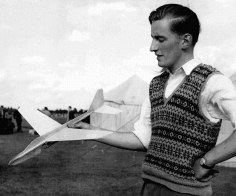
- from Mike Ingram’s personal collection
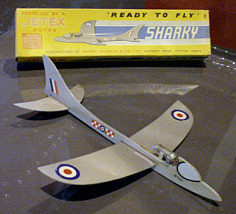
- Howard Metcalfe
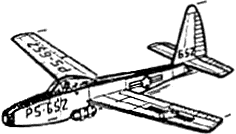 |
|||
|
Late Swallows Femme fatale though it was, the charismatic DH 108 ‘Swallow’ has long been an object of fascination, and, apart from the Hunter, I can’t think of a jet prototype that has been modelled more widely. There were (at least) Howard Boys’ design for his own motors (1947); one was featured in the early Wilmot Mansour demonstrations and advertisements (1948); there was Golding’s for enclosed Jetex 100 (1952) and Coatsworth’s version for centrifugal ducted fan (1952). More recently, Chris Strachan reduced Howard Boys’ design for L1 and I cobbled together a smaller version of Golding’s for (external) L2. Steve Bage has now brought this iconic design right up to date (see August’s article). Steve reports it flies very well with L2s rated between 110 mN and 240 mN, and comments that flying wings appear to be more tolerant in this respect than conventional planforms. As mentioned earlier, it is now available as a ‘short’ Replikit. This includes all parts printed on good quality wood, a canopy nicely moulded by our Chairman and a plan with a short history of the original. So pleased is Steve with this model that he is considering a larger one with an enclosed L3 and a ‘solid’ fuselage. Readers will recall that the internal surfaces of Golding’s fuselage were merely doped, but some sort of protection will definitely be required to protect the wood from Rapier exhaust; an augmenter tube will also ameliorate the losses that enclosing a motor inevitably entails. I have discussed all the models above from time to time. In contrast, the DH 108 on the right has not appeared in SAM Speaks, or indeed any publication, before. It was built, and photographed, by Victor Tester in 1950 whilst he was serving with the RAF in the Far East in Malaya and Singapore. Victor’s son Clive writes: “My father was an aircraft fitter, working on Vampires and Spitfires, and was actually part of the team that assembled the first Vampires to operate out of Malaya and Singapore. “He constructed the DH 108 model while in Singapore. He had no plans to work from, and drew his own from photographs. It was constructed from balsa wood and was not powered. The cloud effect in the ’pseudo flight photo’, which was taken with an inexpensive camera, was achieved using dry ice. “When my father returned to England in March 1953, limitations on luggage meant he had to leave the DH 108 behind, along with other models that he had made during his service.” As can be seen from the photographs, the model was a most realistic rendering of the first prototype. What a pity that it, and others, had to be left behind. Clive lives close to the crash site of TG 306 in Egypt Bay, and has included his father’s story, and that of the jinxed DH 108, in a presentation of local history. French Follies |
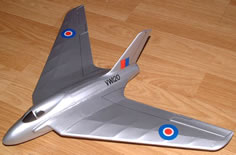
- Steve Bage

- Steve Bage
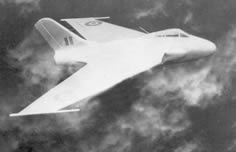 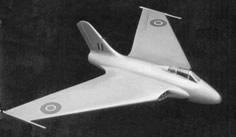
- Victor Tester
|
|||
|
First, regardez les deux images à droite. Dautin was a well-known jet aviateur, being responsible for the Yak 25 for Jetex 50 (1952) and the Convair YF-102, one of the very few (non-American) designs for Jetmaster and augmenter tube (1954). This advertisement for imported Veron products appeared in Le Modèle Réduit d'Avion in 1953. They cost 633 francs, and were, apparently, sold with baguettes. Something to munch on whilst cutting out the formers, no doubt. The other photo, from Mike Ingram’s archive, shows Joe Mansour with the French sales rep. Mike himself is in the background, working on a Hunter. This, and Mike’s beloved ‘cardie’ (did Mike ever take it off? Has he still got it I wonder) gives the year as 1952/53. We know, then, from these and other sources that Jetex was popular in France, and Solido made Jetex motors under licence. These were, according to Bert Judge, rather better engineered than those ‘outsourced’ (a horrible modern phrase) to UK engineering firms. But little of this appears in La Grande Histoire des Petits avions (The Great History of Small Planes) by Jean Champenois. John Miller Crawford has perused this book on SAM’s behalf and tracked down all references to vintage rocketeering therein. Below is a compilation of John’s findings and his translations of relevant passages: “In December 1945, [Maurice] Bayet [editor of Le Modèle Réduit d'Avion], put up a prize with the aim of promoting rocket propulsion. The contest conditions required at least two flights of 200 metres minimum from an obligatory ROG. Armand Barthelmy satisfied these conditions on October 17, 1945, using rockets manufactured by the Ruggieri Company, which had developed them from firework rockets. These weighed 85 grams for 300 grams of initial thrust, dropping to 200 grams. The duration of combustion was 9 to 10 seconds. The only disadvantage was that the rocket might explode after lighting (fortunately this was a rare occurrence), thus destroying the model to which it was attached. These rocket-powered models enjoyed a passing vogue, and only later came back into fashion with the appearance of the English 'Jetex' rockets [les fusées anglaises "Jetex"] in 1951. These 'Jetex' rockets were sold in four sizes: Jetex 50, giving 14 grams of thrust, Jetex 100 with 29 grams, Jetex 200 with 55 grams and Jetex 400 with 140 grams. The operating life was 15 seconds for the 50 and 20 seconds for the others [sic].” (p. 64) |
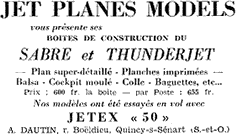
- Le Modèle Réduit d'Avion, 1953

- from Mike Ingram’s personal collection
|
|||
|
John comments here, “Assez maigre, n'est-ce pas? Surely M. Champenois could have replaced those clinical operating details with an account of models and flyers?” Apparently not. John then continues: “There's a tantalising reference to the Bayet prize in the caption to the Sparkling Star (p. 66) [see JXF Oct. 2003] viz: "One of the first post-war rocket powered aircraft was Lucien Dargère's Sparkling Star. It had its sights set on the prize offered by Le Modèle Réduit d'Avion, but saw itself pipped at the post by Armand Barthelmy's flight on October 17.” There's an even more tantalising reference to rocket power in the book’s 'Les Précurseurs' section (p. 21): “In 1903, Henri de Groffigny, taking his lead from Mouillard's experiments, made various attempts at rocket propulsion. At Mers, in the Somme valley, he attempted flight with aircraft of wingspans ranging from 0.7 to 1.2 metres, propelled by cardboard cartridges 40 cm long and filled with powder. His record flight covered 1,100 metres and lasted 84 seconds.” And who is Mouillard, I hear you ask? There was nothing in the index – what index? (a frustrating (lack of) feature of the book). However, I looked him up on the Internet and found that “Louis Pierre Mouillard was an inspiration to many who engaged in aerial pursuits in the last part of the 19th Century. His most well-known book, L'Empire de l'Air, was published in 1881 and became a widely recognized classic.” And that's the sum of M. Champenois’ nods in the direction of propulsion par fusée, as far as I can see (apart, of course, from the illustration of the redoubtable Georges Bougueret). However, the book is a jolly good read – I particularly like the way that he puts the history of the little plane in the socio-political context.” Many thanks, John, for the above. It is indeed an interesting and well-illustrated book though there is rather more about aeromodelling post-1951 than many a committed SAM member would care for, and it would be good if there were an English equivalent. Incidentally, Ruggieri was, or is, a long-established pyrotechnics company. Claude Ruggieri was an early rocket pioneer, whose most notable achievement, in 1806, was to launch a sheep to 600 ft using a cluster of rockets. This sounds more than a little ‘Wallace and Gromit’, and readers will be pleased that ‘Rocky the Ram’, as I think he should be called, was safely recovered by parachute and not turned instantly into méchoui. A repeat mission using a small boy was prevented by the authorities. |

- publ. Editions ELP, 2004
|
|||
|
Rapier Reports With more antique modellers returning to the Jetex joys (or tribulations) of their youth, two tales pertinent to the handling of Rapiers are apposite. First, Sten Persson writes, “Two weeks ago I attended our annual two-day 'Oldtimer Championships' and, as last year, I brought my little SAAB J-29 [the very nice Mike Stuart design, right] for our informal F/F scale contest. Having read your advice on the handling of Rapiers, especially L2 LTs, I predrilled my charges before leaving home. At the contest, in glorious weather, I tried six of them without getting any of them to fire! Having brought only LT Rapiers I gave up, very disgusted! Any further suggestions – apart from throwing them in the bin?” I recommended that Sten rebored them and tried again. He wrote back a little later: “Yesterday evening was warm and calm and so I ventured out again with my J-29. I bored the rockets real deep (at least 3-4 mm as per your advice) and made three beautiful flights without a single misfire! Those flights were longer and more realistic than any of the previous L2 flights and I realize that my J-29 was overpowered all the time, explaining its [previously] erratic flight behaviour. By the way, having found some old, but surprisingly fresh, Jetex wick, I tried to fire a Rapier with it but without success. Perhaps it doesn't burn hot enough or maybe I should try again? A coil of Jetex fuse should last a whole season.” An encouraging story with a happy ending. As to Sten’s last questions, perhaps this batch was substandard, as John Park has had some success with Jetex wick and says the wire core spits out in a most satisfying and authentic manner. The second, more cautionary, tale comes from Howard Metcalfe, who bought a box of L2s from a flying colleague, only to find them already drilled-out. These ignited rather too well, and a couple exploded. Howard now prefills these cores with talcum powder to damp things down a bit and is careful not to put the fuses to the bottom of the bore hole. The implications of Sten’s and Howard’s experiences are that motors should be drilled to 3-4 mm at most; this is better done just before ignition as part of pre-flight preparation, as the fuse then interfaces with a fresh and untarnished propellant surface. It should be emphasised that the drill is of smaller diameter than the nozzle, and my own practice is to tamp propellant removed by the drill back through the orifice, as this prevents putting the fuse in too deep and the small particles are a most efficacious ‘primer’. Meanwhile, Marty Richey in the States has tested some batches of L2HPs, L2LTs and standard L2s with a static thrust rig of his own devising [see discussion on Jetex.org]. Marty is at pains to emphasise that these were limited tests with motors that had passed their ‘sell by’ date. Nevertheless, his preliminary observations rather confirm what we have suspected, i.e., the ratings on the boxes may not reflect that of the contents; L2LTs can punch way above their weight, and L2HPs are more variable than the standard model, with a thrust sometimes below a ‘standard’ L2. Marty also commented on the distorted nozzles and that some L2LT cases came perilously close to burning through towards the end of their extended burn time (up to about 30 sec, almost double that of an L2HP). Marty also advises that models should not be launched during the unpredictable initial ‘spluttering phase’ of a burn, which, according to his instrument, provides little power. This is an enterprise to be applauded: I hope Marty will allow his data to be published once he has refined his methodologies and is happy with the statistical significance of his determinations with more recent batches of motors. |
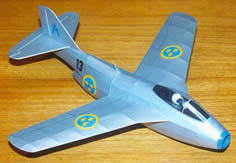
- Mike Stuart
|
|||
|
That all-important second model Once the neophyte scale modeller had mastered the Jetex basics with a model like the Spook, but was not ready to wrassle with a comparatively fragile MiG 15, there were, as we have seen, many nice profile scale kits to choose from. These days there is also a selection of plans from Howard Metcalfe and others if one fancies a more modern prototype like the Harrier, T-38 Talon or MiG 29. The latter is ‘semi scale semi profile’, similar in construction to the J-37 Viggen, an older but most attractive, Sigurd Isacson design [above right]. Similarly, there were many good sport models with a simple all-sheet fuselage and built-up wings from the early fifties that provided a natural progression for the aspiring duration rocket flier. And some not so good. Chris Strachan passed me a copy of Model Aeroplanes by Norman G Taylor [right]. This was published in 1952 as part of Cassell’s ‘New Model Maker’ series. It’s a nice period piece that has some surprising lacunae. Jetex models as such are not described or illustrated; but there is a short, not overly inspiring, section on the motors, and the plans section does, as well as a glider and rubber model, include a Jetex model. The 28" glider (called, somewhat incongruously, ‘Gatwick’) is horrible; I am not competent to comment on the ‘Hendon’ rubber model, but a Jetex design, called, I am pleased to say, not ‘Heathrow’ but ‘Firefly’, is not too inept [see plan below]. The proportions are fine, but there is no provision for adjustment of the flying surfaces (which are simply ‘cemented in place’) and the dihedral is excessive. Unfortunately, and typically for these sorts of books at that time, though Taylor describes trimming in a general sort of way, there are no instructions specific to Firefly. These would have been essential for any young recipient of the book. I wonder how many Fireflies were built. Or, having been built, and decorated in the heavy fashion Taylor describes in his quite idiosyncratic section on finishing, flown successfully. |
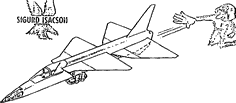 Isacson’s SAAB J-37 Viggen
- SAM 35 Speaks, February 1992 (p. 56)
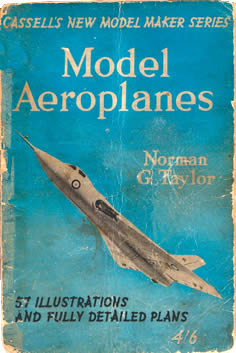
- publ. Cassell, 1952
|
|||
 |
||||
|
|
||||
|
|
|
|||
|
|
|
|
|
|
|
|
Acknowledgements - Article: Roger Simmonds - Illustrations: Roger Simmonds, Steve Bage, Mike Ingram, Mike Stuart, Clive Tester |
|
|
|
|
ABOUT | MOTORS | MODELS | ARCHIVE | HISTORY | STORE | FAQ | LINKS |
|
|
Terms of Use
|
Queries? Corrections? Additions?
Please
contact us.
|
|